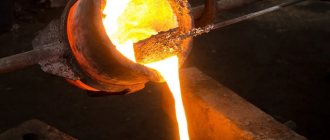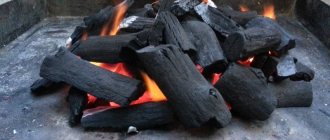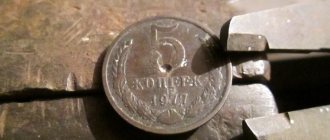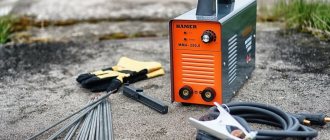There are often situations in everyday life when it is enough to use minimal resources to solve a particular problem. For example, to boil a kettle or heat up lunch in a garage, in a country house or on the river bank, there is no need to build a powerful stove. To do this, it is quite enough to make a small device that will cope with the responsibilities assigned to it, using wood chips, branches, cones, etc. as fuel.
The wide popularity of small stoves, indispensable when camping or fishing, is due not only to their simple design, which lacks batteries and electronic control circuits, but also to the wide possibilities of their practical use, as well as ease of manufacture. Every home craftsman can make a compact wood chip stove if he has the raw material, the right tools and the necessary skills.
Making a wood chip stove with your own hands
Homemade stove
The stove is easy to make with your own hands; it will be difficult to find a similar product in stores. The furnace has a common structure and can be made of various materials. For self-production you will need the following tools:
- angle grinder (grinder);
- Hacksaw for metal;
- Metal scissors;
- Hammer;
- Electric drill;
- Pliers;
- Measuring tool;
- Punch.
At the first stage, a drawing of individual elements of the device is made. According to the diagram, individual structural elements are cut out using a grinder. Typically, a steel sheet with a thickness of at least 1.5 millimeters is used to install a collapsible furnace.
The side elements (4 pieces) have slots and protrusions for mutual fastening of the walls and the grate. To install the grate, you can bend the lower edge of the side walls or cut out the tabs and bend them inward. The upper grille is made of steel wire or small diameter reinforcement. The grille can be removable. The side walls can be secured using bolted connections.
An opening for the door is cut out in one of the side walls using a grinder. Secure the door on the hinges. Sometimes the door is hung on metal wire hooks passed through the holes. Holes are drilled along the perimeter in the side surfaces for air intake. Devices for driving pegs or steel legs (knitting needles, bolts, etc.) are mounted in the lower part of the oven.
For ease of assembly and disassembly, the side panels are often fastened together using door hinges.
Oven from a washing machine drum
Another manufacturing option is to install a stove from a washing machine drum. The drums of the machines are made of stainless steel, which has high strength and durability. To do this, a strip 60 cm long and 200 mm high is cut out. The strip is bent in the form of a cylinder, the joint is secured by folding the edges, riveting or bolting.
The strip is cut with three to four protrusions, which will be located along the perimeter of the circumference of the lower part. The protrusions are bent inward with a hammer, and a grate ceiling is installed on them. The grate is also made from a stainless steel drum - a round blank is cut out with a grinder, and holes are drilled in it.
The upper part is covered with a mesh of steel wire, and a window is cut into the side surface of the cylinder for loading fuel. Legs made of bolts are attached to the cylinder. They can be mounted through protrusions and folds.
Stove made from a placemat and a jar
The device can be made from a cutlery stand. It is sold in household goods stores and is made from stainless steel. There is a cylindrical body with side holes; you need to make an upper grid from wire and secure the legs. A window for fuel supply is cut out in the side surface, and holes are drilled in the bottom. The oven is ready.
A wood chip heater can be cut from a simple tin can with a strong knife or metal scissors. Corresponding holes are cut in the tin, and the upper grille can be woven from wire. Steel knitting needles, thick wire, and so on are used as legs.
How to use such a stove correctly?
There are several rules that will help not only speed up the heating of water or food, but also reduce the risk of overheating of the housing, as well as the severity of the consequences of overheating, that is, thermal deformation and the resulting jamming of parts:
- For ignition you need to use dry kindling and fuel. After all, it is difficult to ignite wet wood even with the help of a hunting match or dry fuel.
- The firebox must be completely filled with kindling and fuel, leaving some space for the movement of air and smoke. This will not only speed up ignition, but also reduce the risk of overheating, because you will not have to add fuel until the stove returns to normal operation.
- If one load of fuel is not enough, then branches and other small wood should be placed behind and on the sides of the heating device at a distance of 2–10 cm. When the wood chipper reaches operating mode, the walls will heat up and begin to dry the fuel. This rule applies to both simple and turbocharged devices.
- It is necessary to close the door after the smoke rising above the stove becomes colorless. This usually happens 1-3 minutes after ignition.
- You can put a pot on the stove only after all the fuel has completely ignited and some of it has burned out and turned into coals (usually this takes 5–10 minutes). If you place the container earlier, the stove’s operating mode will be disrupted, which will sharply increase the likelihood of overheating. In addition, if you install the container earlier, it will become covered with soot, and heating a large volume of water will take longer due to the disruption of the combustion regime.
- If the structural elements are deformed, they must be disassembled immediately after the oven has cooled to a temperature of 70–100 degrees (for this you will need canvas gloves). If you wait until it cools completely, the structure may jam and it will be quite difficult to disassemble it.
- If any part of the stove is hot and turns red, then you cannot add more fuel. In addition, after cooling and disassembling, it is necessary to inspect this part for defects. If there are defects, the part requires replacement.
Types of units
It is customary to distinguish folding wood chippers of triangular, pyramidal and rectangular types, candle stoves, designs specifically for a pot or metal cup, or a flask. The following positions stand out from the features:
- If the stove is designed correctly, it has good draft. It makes it possible to quickly create kindling and the required maximum fire using any available fuel.
- The camp stove-wood chipper is safe to use, it does not emit open fire, and there are no coals left behind that could start a fire. It can be used in places where it is prohibited to make a fire.
- Thanks to its compact size, such a device can easily fit into a backpack for carrying.
- If there is no fuel material suitable for the design, it is recommended to use dry fuel or alcohol.
Durable and reliable, light in weight, the stove will become a reliable companion on the most difficult hike.
By using a minimum amount of branches, cones, bark, and spruce needles, the necessary energy is created; for ignition, a small armful of such materials is enough. And thanks to the original design, the fire is protected from the wind, intensified to the required state, and concentrates heat in the right place. In such a stove it is convenient to dispose of garbage that appears while being outdoors. It can be used instead of a candle for minimal lighting; it is convenient to heat aromatic oils and special liquids that repel mosquitoes and midges.
Design features
Typically, a cylindrical furnace is made from a pipe or individual parts of a rectangular cross-section. Its height is most often about 20 cm. A so-called grate is constructed in the lower part, and holes are created on the side through which air enters to ensure combustion.
The upper plane is represented by a grate, on which it is convenient to place dishes with food or water. In the other side part, a small rectangular hole is created with a door into which the fuel used is placed. Small segments for skewers are cut along the top edge.
The finished structure is complemented by legs, which provide clearance directly under the grate. The ash remaining after the burnt fuel pours out through it, and air enters. The legs also provide stability to the stove; if not properly supported, it may fall on its side.
Pyrolysis camping devices – truth and myths
Often on the websites of online stores selling these products, some heating devices are called pyrolysis woodchip stoves, arguing that the fuel undergoes a pyrolysis process and releases pyrolysis gas, which then burns in the “pyrolysis” department (afterburner).
In fact, pyrolysis is the thermal decomposition of wood with a lack of oxygen and the almost complete absence of open fire.
In the same heating devices, thermal decomposition of wood occurs with an excess of both primary (in the firebox) and secondary (in the “pyrolyzer”) oxygen , which comes with the air.
Therefore, the name “pyrolysis” is just a marketing ploy , the purpose of which is to attract the attention of people familiar with this term, but who do not delve into the specifics of the operation of the proposed stove model.
However, most "pyrolysis" wood chippers are more efficient than their simple counterparts.
This is due to the fact that the flame receives secondary air entering through the openings in the housing, due to which the hydrocarbons burn more completely, this leads to an increase in the fire temperature for the same amount of fuel .
Often, wood chip stoves that do not have the definition “pyrolysis” in their name are equipped with the same holes, so it is necessary to choose heating devices that provide air supply above the combustion zone, that is, in the afterburning zone.
Wood chip stove under an army cauldron
In camping conditions, to make a fire you will need to prepare dry firewood, which is not always possible, especially after rain or snow.
An alternative to a fire is a wood chip stove; all you have to do is pour wood chips into the stove, light it, and put the pot on.
- Making a wood chipper is not difficult; all you need is a piece of tin or thin metal from which you need to cut out the stove parts.
- Make drawings on a sheet of metal, then use metal scissors to cut out blanks where you need to drill holes with a drill.
- After that, the workpiece must be attached to the pot and given a shape that follows the contours of the pot.
- The wood chip stove for the army cauldron is ready for use.
- A reliable, durable pyrolysis stove for use in tourism, hunting and fishing, rafting and in mountainous areas, where there is a shortage of firewood.
- Uses natural traction.
- High efficiency, economical fuel consumption, less firewood is required than on a fire.
- The temperature during the cooking process can be controlled by the fuel supply.
- The fuel for the stove is wood chips, twigs, cones, etc.
- During transportation, the pot is placed inside the stove.
- For transportation, the stove is packed in a case.
Do-it-yourself camping wood chip stove: drawings and photos of step-by-step production of a homemade stove from cans.
This homemade product will primarily be of interest to lovers of hiking; on every hike it is very important to provide yourself with a source of fire to cook food, boil water for tea, and warm up. Expert opinion Dmitry Timofeevich Tarasov Master of Sports in mountaineering. Author of scientific articles on the topic of survival in the wild
Author of scientific articles on the topic of survival in the wild
You can make a regular fire, but it will take time to collect firewood, and if it rains, then finding dry firewood in the forest and lighting a fire will be problematic.
Expert opinion Dmitry Timofeevich Tarasov Master of Sports in mountaineering. Author of scientific articles on the topic of survival in the wild
You can make a regular fire, but it will take time to collect firewood, and if it rains, then finding dry firewood in the forest and lighting a fire will be problematic.
As an option, you can make a wood chip stove and take it with you on a hike. What are the advantages of such a camping mini stove?
First of all, minimum fuel consumption, which can be used as small wood chips, branches, bark, pine cones, and dry grass. The design of the wood chipper is made in such a way that an air flow is formed in the outer chamber, which enhances the combustion process in the stove.
In fact, with such a camp stove you can heat up food or boil water using just a handful of wood chips, which can be prepared easily and very quickly.
The figure shows an approximate cross-sectional drawing of a wood chip stove.
Next, we look at the step-by-step process of making wood chips with your own hands.
The materials you will need are 3 tin cans, one larger and two slightly smaller.
We take a large jar, mark the places and drill holes in it near the top edge as shown in the photo.
Now let’s put the first jar aside and modify a slightly smaller jar, punch a lot of small holes in the bottom of the jar, and drill holes in a circle around the top edge.
We take this smaller jar and insert it into the larger jar as shown in the photo, fix the jar in the hole of the larger jar (to do this, make a hole in the bottom of the larger jar the size of the inner jar).
The stove is almost ready, let's make a stand for a mug from the third narrow can, the stand is needed so that the mug does not cover the flame of the stove.
We take a shallow jar and drill holes in a circle along the side.
That's all, we made a wood chip stove from cans, I recommend watching the video where the author shows how to properly make and heat this mini camp stove.
Expert opinion Dmitry Timofeevich Tarasov Master of Sports in mountaineering. Author of scientific articles on the topic of survival in the wild
Using a wood chip stove helps out in many life situations. This equipment is especially suitable for hiking conditions and operation in open areas. The country house equipment market is filled with various models of wood chip stoves with individual qualities.
But such a structure can be built with your own hands. The main difference between the choices is that handmade products are guaranteed to have just the right features: simplicity and reliability.
Device from a can
The simplest option for a camping stove is to make it from an ordinary tin. So, the starting material is an ordinary food can, in which small holes are made along the entire perimeter to ensure proper air circulation. The finished miniature design is perfect for one person; it is convenient to heat a mug of water or tea using dry fuel or a handful of wood chips. Advantages of this design:
- Very low fire safety and compact dimensions, and fuel material for such a wood chipper is easy to find during a hike. As for the efficiency when burning wood, it is an order of magnitude higher compared to a regular open-air fire, but less than in a turbo stove.
- A device made from a tin can can be used during fire season, since there is no open fire.
- It should be remembered that the wood chipper is not suitable for serving a large group of people. It is designed for one, maximum two people.
Wood chippers in various interpretations are sold in stores; they are usually made of stainless technical steel, the thickness of which does not exceed 1 mm. Their advantage is quick assembly. Also, such structures are compact and lightweight, since they consist of only a few flat elements. They are often used by cyclists, mountain climbers who spend their leisure time in harsh conditions.
For greater convenience during operation, the devices are packaged in special cases designed for transportation and subsequent storage.
How does it work?
The principle of operation of a wood chipper is in many ways similar to the principle of operation of other solid fuel stoves - the fuel found in the firebox, that is, wood chips and small branches or cones, burns, releasing heat, which heats the container located on top.
The same process occurs in wood chip stoves without holes in the side walls, but with a gap between the top of the stove and the heated container.
However, the efficiency of wood chippers is much higher than that of conventional solid fuel stoves, and the reason for this is the excess air supply.
cannot be operated in minimum power mode
Another significant advantage of excess air intake is the almost complete absence of carbon monoxide in the smoke, that is, carbon monoxide (CO), which during the afterburning process turns into carbon dioxide, that is, carbon dioxide (CO2).
Despite the fact that carbon dioxide is also poisonous, its permissible content in the air is almost 30 times higher than for CO. Therefore, you can use wood chip stoves even in tents with poor ventilation systems, although it is better to use them outdoors.
Indeed, even with the most complete combustion of cellulose, carbon dioxide is released, which displaces oxygen from the air, resulting in oxygen starvation, and this can lead to loss of consciousness or death.
Buy or make?
This article describes how to make a wood chipper with your own hands. There are many types of ready-made camping wood chippers on sale, but it’s not even a matter of obviously inflated prices; in monetary terms they are generally acceptable. The fact is that marketing-oriented “improvements” of many factory-made wood chippers actually deprive them of their main advantages: simplicity, reliability and versatility (see below, about turbo chippers). Therefore, it is better to make a wood chip stove yourself.
Folding and non-folding designs - what's the difference?
The main advantage of collapsible models is that the stove, folded and stored in a case, takes up very little space. In most cases, the size of the case with the parts placed in it does not exceed the dimensions of a pack of Belomorkanal cigarettes or a couple of packs of regular cigarettes.
The disadvantage of a collapsible design is that it is slightly heavier than a non-dismountable one, as well as less rigidity, so awkward movement can lead to the collapse of the entire structure, after which it will have to be cooled and reassembled.
The non-separable design does not have these disadvantages, but is noticeably larger in size. Most often, a non-separable design is used to make round wood chippers, which are comparable in size to a thermos with a volume of 0.5–2 liters.
Round stoves are not only stronger and stiffer than rectangular collapsible ones, but also have greater efficiency, because additional air enters the afterburning zone, increasing the efficiency of fuel combustion.
Another disadvantage of non-separable round devices is that they are difficult to heat rectangular or elongated containers, that is, most types of soldier’s pots. There are also round collapsible structures, but even when folded they take up noticeably more space than collapsible rectangular ones.
The remaining parts are turned over and inserted into the lower part, forming a kind of nesting doll. But in round devices, especially with double walls, the supply of secondary air to the afterburning zone is better implemented, which increases the efficiency of the heating device.
Selecting a housing type
All stoves can be divided into:
- rectangular;
- round.
rectangular because the parts for this shape are easy to manufacture.
Round ones are more difficult to manufacture, so they are made from ready-made cylinders or glasses made of a suitable metal.
Even if a round heating device is made collapsible, in transport condition it will always be noticeably larger than a rectangular one.
Manufacturing options
With a certain set of equipment and skills in working with metal, making a wood chip stove will not be difficult. There are several current options.
From the drum of a washing machine
It’s possible to adapt a worn-out washing machine into an excellent outdoor fireplace. To install the stove you will need a washing machine drum. The holes around the perimeter of the drum will provide a constant flow of oxygen and also serve as decoration.
The diagram shows the possible dimensions of the manufactured furnace.
Materials and tools:
- Drum.
- Angle grinder and grinding wheel.
- Wire brush.
- Cutting wheel for metal.
- Metal corners and flat workpieces.
- Heat-resistant paint.
Instructions:
- First you need to remove the drum and remove all dirt. You should also clean the rim of any plastic parts.
- Cut off the main spindle and the fold at the top to make the piece look better.
- Use a sander to remove any uneven surfaces at the bottom.
- Remove any remaining old foam.
- Make legs from fasteners so that the stove is at a distance from the surface.
- The final stage will be painting the stove.
Wood chips from a washing machine tank
From the cutlery stand
Using an ordinary cutlery stand you can make a simple wood chip stove. The design will last a long time, because This kitchen item is made of food grade stainless steel with thick walls.
To make such a structure, you need to take:
- four bolts with nuts.
- metal rods.
- marker for marks.
- Bulgarian
- steel partitions, metal chain (optional).
Instructions:
- The legs will be bolts that need to be attached to the bottom of the stove. The rods are inserted through the upper holes. This is how you get a tray for dishes.
- The system can be improved using a variety of stands. To do this, four markings are made on the rim of the stand and cuts are made using a grinder. The cross stand is strengthened into the formed grooves.
- The same action should be performed with the bottom of the stove. This is necessary for the formation of greater lift and good access of oxygen.
Option 1
Option 2
From a can
A good solution for tourist events can be the use of a wood chip stove made from cans. The advantages of this design are that assembly requires a minimum set of tools and a small amount of time.
To work you will need:
- Two tin cans of different diameters.
- Knife.
Manufacturing instructions:
- To begin with, in a smaller jar you need to make holes at the bottom and sides, near the rim.
- Then take a second can, make holes along the rim and remove the bottom.
- Insert a smaller jar into the hole formed.
- Make a stand for the heated dishes.
Stages of making wood chips from a can
This stove would be an ideal solution for use by one or two people. Despite the simplicity of the design and small dimensions, a fairly strong hearth is created in a stove made from cans. It is also worth noting the environmental friendliness of such equipment.
Foldable design
The folding camp stove-wood chipper is compact and easy to carry.
To assemble such a stove you will need flat metal parts. When assembled, the folding stove looks like a small square package. It should be remembered that the corners of such a product are sharp, so folding wood chip stoves must be placed in a special bag or container.
Materials and tools:
- Sheets of steel (no thicker than 2 mm) and wire (no thicker than 3-4 mm)
- Metal hacksaw, file.
- Drill, hammer, for bending steel.
- Pliers
- Bench punch.
- Suitable fasteners.
Drawing:
Manufacturing instructions:
- Using the drawings for making a wood chip stove with your own hands, you need to make a plan on a paper sheet.
- Transfer the design to the metal and correctly cut out all the necessary elements.
- Drill holes for the wire on all parts of the walls of the future stove.
- Using wire, assemble the walls and bottom of the stove.
- Make a mesh for dishes.
Parts assembly diagram
It is not difficult to make such a unit with your own hands. The advantage of this design is obvious: the stove is easy to assemble, like a construction set. Using the drawings greatly simplifies the construction of a wood chip stove with your own hands. Basic skills and tools will allow you to create an always-in-demand structure for heating and cooking food in camping conditions.
A little history
The wood chip stove, apparently, was invented by Russian gold miners in Chukotka, when American canned food began to arrive there through Alaska (then still Russian). After Alaska became the property of the United States, many of our compatriots remained there; The surname of the main character of one of the famous stories of Jack London's Alaskan cycle is Souvarine. To the American prospectors and pioneers of the Klondike, the wood chipper was known as the Russian Can Stove.
The properties of wood chips as a means of survival were fully appreciated by Stalin's prisoners. From them, the NKVD guards also learned about the wood chipper. Pre-war survival manuals for scouts include instructions for making wood chips. It was nicknamed Bond's stove thanks to the screenwriter of one of the Bond series - an avid hunter, fisherman and single tourist. The screenwriter and the actor who played Agent 007 in that episode need to say a huge thank you without any pretense. Einstein once put it: “If you have an apple and I have an apple, and we exchange them, then we will each have an apple left. And if you have an idea and I have an idea, and we share them, then each of us will have two ideas.” The idea of the Russian Can Stove saved the lives of dozens of people already during the exploration of the Klondike; by now their number, worldwide, is likely to be in the hundreds, if not thousands.
Wood chip stove diagrams, drawings
Thanks to its compact size, the stove does not take up much space and weighs little. This compares favorably with a gas burner, for which gas cylinders are required. The total weight of the burner with cylinders reaches several kilograms
.
A wood chipper weighs about a kilogram, depending on its design .
Photo 1. Drawing of a square wood chip stove. Contains four parts, the dimensions of each element are indicated.
The design is easy to make yourself from available materials.
For one person it is made from a large tin can. The larger version is assembled from the drum of a used washing machine.
Photo 2. Drawing of a cone-shaped wood chip stove. Such a device can be folded like an accordion.
sheet metal is suitable as a material
There are several types of structures. They differ in form and scope of application.
Important! All devices have air intake holes at the bottom. This ensures good traction and fuel combustion
First: stove under the pot
This option is intended for use on hikes
, mainly in singles.
Most tourists have a standard size army bowler hat. The oven is made for it. The shape of the wood chipper is similar to a cooking container
. This design option is the lightest.
Reference.
The dimensions of the stove are selected in such a way that the pot fits without a gap.
Then it heats up faster, since the heat does not escape out through the cracks. To make adjustments, a drawing of the bottom is made by tracing the lid of the pot with a flange
.
Second, square
Most cooking utensils are still round in shape, so the previous option is not suitable for it. A square-shaped wood chipper will come in handy both on a hike and at the dacha
If you make it collapsible, the device will be more convenient to transport and store. Dimensions are increased proportionately if necessary.
The shape of the holes in the side walls can be any.
Third trapezoid
This wood chip stove is also foldable, but it is assembled like an accordion, rather than being divided into separate parts. It differs from the previous one trapezoidal shape.
Such a stove is more stable; the heat in the device is concentrated in the central plane.
If the top of the structure is made too narrow, some of the heat will be lost through holes in the upper side of the walls. The device weighs approximately about a kilogram.
General concept
The wood chipper is a worthy alternative to a standard gas burner, for which it is not always possible to purchase special cartridges when traveling and far from civilization. And taking them with you on a hike would not be the best idea. In such a situation, a mobile and compact stove is suitable for heating or fully cooking food. It perfectly holds the necessary fire on cones, small brushwood, dry fuel, and serves as an excellent way for heating.
The best ready-made models
Ready-made stoves can be purchased on any suitable website or in construction stores. Another interesting solution would be to buy a stove from the well-known Aliexpress website.
Turbo oven PS1500T
This option showed excellent results at low temperatures.
The stove does not require large supplies of firewood and saves a lot of time and effort. The blower in the furnace system allows you to gain high power in a matter of minutes. Even raw wood can be used as fuel.
The PS 1500 T turbo stove kit includes the following parts:
- electric air blower,
- stainless steel housing,
- the combustion chamber,
- stand.
The supercharger runs on two AA batteries. Operation is possible in three modes:
- High fan speed (3000 rpm).
- Low fan speed (1500 rpm).
- Off — when switching off, the supercharger must be removed to avoid overheating. In this case, the oven will continue to operate thanks to natural draft.
On one set of alkaline batteries, in different modes, the oven will work for about 50 hours.
The price range of the PS 1500 T turbo oven is 2500-3000 rubles.
Forest gnome
This is a compact, prefabricated oven. To assemble and disassemble this option, no tools are required. The oven is made of high quality stainless steel.
The main advantage of the Forest Gnome is its versatility. The unit is equipped with three grate compartments. Low for wood fuel, medium for alcohol. The upper compartment is used for dry fuel.
Advantages of the Forest Dwarf stove:
- The grate rises above the ground, providing air access to the flame.
- It is also noteworthy that the design can be supplemented by installing walls for pyrolysis.
- This version of the folding stove is safe to use, because its design is a closed space.
- There is no need for a large supply of firewood; you can use any forest debris, including cones.
- Quality of materials. The thick food grade steel used to create the oven will last a long time.
- The set of the Forest Gnome stove includes a folding stove and a cover. The cost of the device is about 1000 rubles.
Biohit 123
- This stove is a non-separable structure that can be used as a stand-alone stove.
- The equipment is supplemented with special crosshairs.
- The structure consists of three parts:
- The first part serves as a stand and is necessary for stability.
- The second part is the firebox.
- The third part is the second crosshair on which the dishes are installed.
- In the combustion part there is a tray for wood fuel. The design also has an additional slot with a door for storing firewood.
Advantages of the Biohit 123 stove:
- No assembly required.
- Always ready to work.
- Long service life due to bent structure.
- The stove can be used as storage for small items.
- An additional fuel tray is included in the package.
- Dry fuel is suitable as fuel.
One of the disadvantages of the stove is its inconvenient dimensions.
The cost of a non-separable stove Biohit 123 varies in the range of 1500 - 2000 rubles.
Survivor #2
- This option has a large set of positive qualities:
- The continuous operating cycle is 10 hours.
- Long service life.
- The ash pan is designed like a full-fledged stove. Equipped with a large door.
- An improved type of fastening that increases the strength of the structure.
- The volume of the installed container is up to 30 liters.
- Due to the high efficiency coefficient, fuel consumption is minimized.
- Convenient system. The door is equipped with grooves made in the form of a slide. Therefore, the door can cover both the firebox and the vent.
- It is worth noting the material used to make the stove. The stainless steel alloy contains nickel and is non-corrosive. The product is resistant to various chemical environments. Also, the wood chip stove “Survival No. 2” has high mechanical loads.
- The price of the stove is about 1000 rubles.
Advantages and disadvantages of a turbo stove
Sometimes, to increase the efficiency of fuel combustion, the heating device is equipped with a turbocharger powered by AA batteries. This increases the cost of the device, but such a turbo wood chip stove allows you to quickly heat water or food with the same amount of fuel.
In addition, wood chippers with a turbine are made in a non-dismountable version, which is why
they take up much more space .
A serious advantage can be considered the ability to work even on raw fuel , because thanks to the constant flow of air, the wood quickly flares up and burns, releasing the maximum amount of heat.
However, experience shows that turbocharged devices have no real advantages , because even raw wood chips can be dried by stacking them around the stove.
If you take dry alcohol or paraffin-soaked paper napkins with you for kindling, then all the advantages of turbocharging disappear, and there is no point in carrying a rather large and heavy unit with you on a hike, even if some of its parts can be removed.
Therefore, turbocharged devices can rather be classified as exotic toys. Moreover, on a long-term hike the batteries will quickly run out and the heating device will turn into ballast .
Folding
The next most popular wood chip stove is a camping and country folding one. Such wood chippers are assembled into a working configuration from flat parts, which when folded form a compact package. It is placed in a cooking container or in a special pocket inside the backpack so that the corners do not tear anything. Due to its compactness when folded, parts of the folding wood chipper can be made from ordinary structural steel with a thickness of 1-2 mm. The weight of installation in the stowed position then increases to 0.8-1.2 kg, but the stove turns out to be quite durable without the use of special steels. In addition, the same approach allows you to make a summer wood chipper of increased size, on which you can cook lunch for everyone in a cauldron or boil a bucket of water.
Drawings of parts for a camping folding mini stove-wood chipper
Mini hiking
Drawings of the parts from which the folding camping mini wood chipper is assembled are shown in Fig. higher. The assembly process is simple:
- wing a Det. 4 is inserted into cutout a' Det. 2;
- hooks b of Parts 1 are inserted into the cutouts b' Det. 2;
- Parts 1 are moved slightly apart and pushed down until they stop;
- Det. 4 is raised and Parts 1 are brought together so that its wings c' fit into the cutouts c of Parts 1;
- The stove is fixed in assembled form by putting Part 3 with its grooves d' onto the hooks d of Parts 1.
Folding country house
A country folding wood chipper must, firstly, withstand a significant load. Secondly, with its increased dimensions, it becomes difficult to ensure a variable combustion mode by simply drilling holes in the sidewalls. Thirdly, a country wood chipper should make it possible to place dishes of different sizes on it, and at the same time, the requirements for maximum compactness when folded and minimum weight are not necessary for it. In Fig. Patterns of the sidewalls of a country wood chip stove that meet these conditions are given; side of the square of the scale grid - from 10 to 50 mm, depending on the purpose of the furnace and the availability of material.
Patterns of parts for a folding country stove-wood chipper
Material – structural steel with a thickness of 1.5-2.5 mm. The red-filled blades of the sidewalls, forming the burner, bend inward at angles of 45 degrees after cutting out the blanks. This ensures, firstly, the possibility of installing vessels of various sizes on the burner. Secondly, together with the shaped cutouts at the top, the dimensions and configuration of the bottom of the installed vessel, the flow of secondary air is regulated, i.e. This stove is self-adjusting according to the cooking utensils. If you put a frying pan or a small saucepan, it will burn longer, but heat less. Under a large cauldron with a rounded bottom it’s stronger, under a bucket it’s even stronger, and under boiling water it’s generally at its maximum.
Folding pyramidal wood chip stove
About pyramidal wood chippers
Sometimes amateur designers, in order to achieve more complete combustion of fuel, make folding wood chips of a pyramidal shape. Indeed, in such furnaces the share of pyrolysis in the heat release increases. But the additional heat is easily lost, as can be clearly seen in Fig. on right. The stove is not a cooling tower after all.
The main pros and cons of a wood chip stove
It is reasonable to consider the effectiveness of a wood chipper in two planes. In the first plane, compare its efficiency with other designs of camp stoves. In the second plane, it is worth analyzing how effective small-sized stoves themselves are in their class, ranging from full-body ones to turbocharged devices.
Comparisons of wood chips with other designs
Many innovations can be incorporated into the design of an ordinary camping stove, but in terms of energy efficiency, it will be possible to increase the efficiency only by using the technology of afterburning pyrolysis gases. In this case, the design turns out to be unreasonably complex and quite heavy. At the same time, such a stove will perform the function of heating water and cooking food rather difficultly; too much energy is needed to heat the body itself. Plus, it will not be possible to immediately raise the temperature in the firebox to the required 450-600 degrees to start decomposing the wood into light gases.
With an open fireplace, everything is much simpler; here, thanks to the small size of the fuel particles, the wood heats up faster and the process of burning light gases begins. The combustion process itself does not spend a large amount of energy to heat the metal body, but immediately releases heat to heat the cooking container.
The efficiency of wood chippers among mini-kilns
When it comes to efficiency among the mini ovens themselves, ovens with a non-removable body have many advantages over folding ovens and fan-powered super ovens. Of course, models equipped with a turbine reach maximum combustion mode faster, but the question is how long the batteries will be enough to power the electric motor. Collapsible models are convenient for preparing dishes where fire is required for a long time, for example more than 30 minutes. But in terms of quick heating or making tea, a stove with a non-separable body is still more effective.
The advantage of this model lies in the specific shape of the firebox and the channels through which air enters the hearth. The firebox itself, representing a metal glass, supports combustion in the upper part, the incoming oxygen through the channels between the hearth and the outer body is heated and enters the combustion zone at a temperature of 100-150 degrees, this is quite enough for the process of releasing flammable substances to proceed faster. Thus, already 3-4 minutes after the wood begins to burn, the temperature rises to 350-450 degrees.
Emergency
Finally, let's see how to make a wood chipper as a last resort from scrap materials. At pos. 1-3 fig. the same Russian Can Stove that survived unchanged to Bond’s stove. This kind of wood chipper is primarily used for heating: the combustion in it is quiet and superficial. A surface burning wood chipper produces a weak flame, but a lot of soft heat. When starting in a tent, you can use a metal bowl as a tray, into which small pebbles of approx. same size. Not sand, you need air flow! You also need to place something under the bowl that is not self-igniting and does not conduct heat well: the bottom of the stove, when the load burns out, heats up to 300-400 degrees, and the bottom of the bowl through pebbles 2-3 cm in diameter to 140-160 degrees.
Camping stoves made from cans
By the way, the best fuel load for an emergency surface burning wood chipper is a tightly stuffed roll of toilet paper, also tightly packed medical cotton wool, etc. loose fuel, which contains more cellulose and less of something else. To ignite, you need 30-100 ml of alcohol or any other flammable liquid, strong alcohol (vodka, cognac, local moonshine) or vegetable oil. The fuel load is pierced along the axis to the bottom with a pencil, writing pen or sharpened stick, doused with kindling and set on fire. It burns for a long time, without soot, and produces a lot of heat.
If among the empty cans there is a pair that fits into one another, then from the cans it is possible to quickly assemble a wood chipper with a mixed combustion mode that is more economical and suitable for making tea or soup in a mug, pos. 4 and 5. The holes, of course, do not have to be so neat; they can simply be punched with a knife. If the stove will be loaded with loose fuel, holes in the inner can must be pierced from the inside so that burrs do not interfere with loading. Also, 1-3 rows of holes are punched at the top in the shell (cylindrical sidewall) of the inner can. Branch fuel is loaded to the bottom edge of the holes in the top row, pos. 5. These, of course, are not all options for wood chip stoves as a last resort; Other quite effective designs of camp stoves made from cans are also possible, see for example. video:











